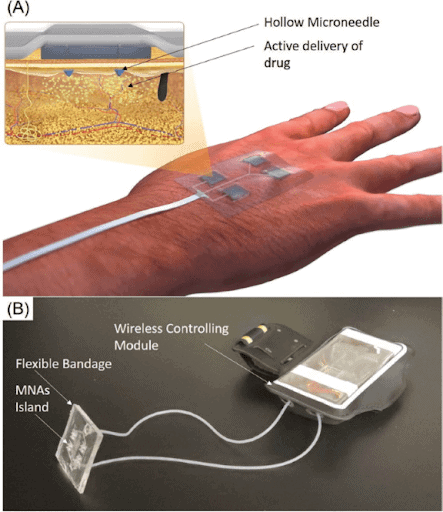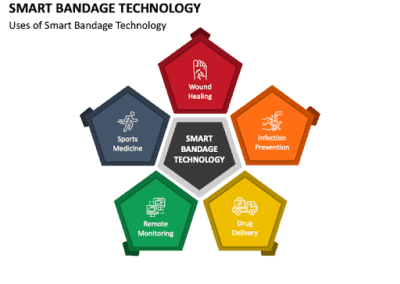Chronic wounds pose a significant challenge to millions worldwide, particularly for those with underlying conditions such as diabetes that complicate the healing process. Advances in medical technology have led to the development of smart bandages that actively monitor and respond to the state of the wound. An innovative advancement in this area involves wearable devices with miniaturized needle arrays. These devices improve treatment delivery to affected tissue, potentially accelerating the healing process. Additionally, the CellScale UniVert system enables seamless compression force testing. Testing compression aims to evaluate the efficiency of data storage and transfer, ensuring optimal performance and reduced file sizes.
These wearable devices represent a fusion of biomedical engineering and material science, where precision and personalization in wound care are becoming achievable. Smart bandages equipped with miniaturized needles can deliver drugs, collect fluids, and monitor several parameters crucial for wound healing. This technology aligns with the ongoing shift in healthcare towards more personalized, home-based monitoring and treatment, offering a promising approach to managing chronic wounds and improving patient outcomes.
Key Takeaways
- Wearable devices with needle arrays are innovating the management of chronic wounds.
- Smart bandages offer precision treatment and real-time monitoring, improving personalized care.
- Despite the promise, advancing these technologies faces challenges and necessitates further research.
Technology Behind Wearable Devices
What is Smart Bandage Technology?Smart bandage technology combines advanced materials with innovative engineering to create responsive and multi-functional dressings that actively participate in the healing process of chronic wounds. These bandages are equipped with miniaturized needle arrays, wireless monitoring systems, and drug delivery mechanisms, making them standout examples of 3D-printed medical technology with a high focus on biocompatibility and patient comfort.
Miniaturized Needle Arrays
Miniaturized needle arrays are integral to smart bandages, allowing for both efficient delivery of therapeutics and interstitial fluid sampling. These arrays, often 3D-printed, achieve precise penetration with minimal discomfort. This proves invaluable in treating chronic wounds by facilitating the direct administration of drugs to the affected tissue, significantly enhancing the healing process.
Wireless Monitoring and Drug Delivery
The wirelessly controlled smart bandage employs sophisticated sensors to monitor wound parameters such as temperature and pH levels. These data points are wirelessly transmitted, enabling real-time tracking of the wound’s healing progress. Coupled with intelligent algorithms, these bandages can autonomously deliver the necessary drugs at the opportune time, optimizing the healing environment.
Biocompatibility and Design
A crucial aspect of smart bandages is their biocompatibility. Materials are carefully selected to ensure safety and compatibility with body tissues, reducing the risk of irritation or allergic reaction. The design of these bandages is tailored for optimal fit to various wound sites, taking advantage of innovative materials that can conform to body contours while maintaining functionality.
By integrating miniaturized needles, smart technology, and biocompatible design, smart bandages represent a significant leap forward in the field of wound care, particularly for the management of chronic wounds. The research and development in this domain, as evident in the work by labs like that of Ali Tamayol, showcase the potential to revolutionize healing processes and improve patient outcomes.
Clinical Applications and Efficacy
The integration of wearable devices outfitted with miniaturized needle arrays presents a significant advancement for the management of chronic wounds, offering precise drug delivery and enhanced healing.
Wound Healing Enhancement
Miniaturized needle arrays can promote wound closure and angiogenesis, crucial processes in tissue regeneration. For diabetic mice, this technology has shown promising results in accelerating wound healing, potentially transferring these benefits to diabetic patients as well.
Diabetic Ulcer Treatment
Specifically for diabetic ulcers, wearables with miniaturized needles enable controlled drug release directly into the affected area. This method assists in maintaining an optimal healing environment, thus improving patient outcomes.
Antibiotic Topical Administration
For wounds complicated by bacterial infection, the wearable technology allows for antibiotic topical delivery, targeting the infection site directly. This could reduce the need for systemic antibiotic treatments and minimize potential side effects.
Challenges and Future Directions
The evolution of wearable devices for chronic wound management represents a significant leap forward, but it is not without its set of challenges and expectations for progress. Your understanding of these aspects is crucial for appreciating the cutting-edge solutions and the potential they hold for the future of personalized medicine.
Limitations in Current Therapies
Current chronic wound therapies often fall short in addressing the complex needs of wound healing. Despite progress in treatment approaches, limitations such as inadequate delivery of vascular endothelial growth factor (VEGF), which is essential for angiogenesis and healing, remain. Furthermore, the risk of limb amputation, especially non traumatic limb amputation, is still a devastating reality for many patients with severe wounds that do not respond to traditional therapies.
Advancements in Smart Bandage Technology
Recent technological advancements have led to the development of smart bandage technology. These bandages are part of a programmable platform that can actively monitor key wound indicators. For instance, a wirelessly controlled smart bandage with miniaturized needle arrays can precisely deliver drugs or collect fluids, significantly mitigating pain and inflammation and reducing scar formation. This transformative approach paves the way for active drug delivery systems that are more responsive to the wound’s condition.
Potential for Personalized Medicine
The potential for personalized medicine within the realm of wound care is immense. By utilizing advanced wearable devices equipped with sensors and miniaturized needles, it becomes possible to collect real-time data, optimizing treatment protocols for individual patients. This capability not only enhances monitoring but also allows for adjustments in therapy that are aligned with the body’s healing process and patient’s recovery trajectory, significantly cutting down the risk associated with chronic wounds and limb loss.
Through addressing these challenges with innovative technology, there is a promising future where management and healing of chronic wounds become more effective, reducing the overall burden on healthcare systems and improving patient outcomes.
In the above article, all compression force testing was done with the CellScale UniVert. Learn more about the Univert here.










